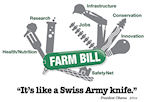House Ag Committee does its 'duty' in deficit reduction
House ag members point out to Budget Committee that 2014 farm bill reforms achieving greater savings than if 2008 farm bill had continued.

On Tuesday, the House Agriculture Committee approved and sent its Budget Views & Estimates letter for fiscal year 2017 to the House Budget Committee.
In the letter, the members requested that the House Budget Committee "give careful consideration to the significant contributions toward deficit reduction already made by the committee on agriculture, the substantial reforms these savings entailed, the troubled economic conditions facing farm country that are exacerbated by regulatory burdens and trade and tax uncertainties, as well as our committee's work ahead, when determining from which congressional committees and mission areas any future budget savings should come."
The committee also noted that “almost $5 billion from agricultural policies have been sequestered since fiscal year 2013, accounting for a disproportionate 30% of the non-defense, non-Medicare mandatory sequester last year,” and that “the 2014 farm bill reforms are achieving far greater savings than would have been realized had the status quo under the previous farm bill been maintained."
In his opening comments of the brief meeting to approve the budget letter, House Agriculture Committee chairman Michael Conaway (R., Texas) said, “From our perspective, we continue to believe that the committee on agriculture has done its duty for now, with respect to deficit reduction, and that the areas constituting the other 98% of the federal budget ought to be looked to first for any additional savings being sought this Congress.”
The letter noted that economic conditions for many farmers have changed dramatically since the farm bill debate, with commodity prices plunging. For example, the price of corn, the nation's largest cash crop, has fallen almost 47% since 2012. Milk prices have also collapsed, falling approximately 40% over the last year. While cattle prices had been one of a few remaining bright spots, they, too, have fallen precipitously over the past six months.
Drought and other natural disasters also resulted in disaster declarations for 57% of counties in 46 states last year. The net effect is an estimated 55% decline in net farm income from 2013 to 2015, the largest two-year percentage decline since the farm crisis of the 1920s.
Yet, despite this economic turbulence in rural America, the Congressional Budget Office's (CBO) January baseline projects that the commodity title of the farm bill is still slated to save taxpayer money relative to the repealed Direct Payment Program over the next 10 years, the letter states.
“Had the 2014 reforms not been enacted and the 2008 farm bill remained in effect, the (University of Missouri) Food & Agricultural Policy Research Institute estimates that farm policy spending would be $17.7 billion higher than it is today. In other words, the 2014 farm bill reforms are achieving far greater savings than would have been realized had the status quo under the previous farm bill been maintained,” the members wrote.
The letter notes that “farmers and ranchers have little choice but to add an unpredictable Washington (D.C.) and media ridicule to the long list of challenges they must manage.” Farmers continue to come under fire for government support, especially with attempts to reduce crop insurance premium assistance.
The letter states that despite the importance of crop insurance, the 2008 farm bill reduced crop insurance by an estimated $6.8 billion at the time; the renegotiation of the Standard Reinsurance Agreement further reduced the CBO baseline for crop insurance by more than $6 billion, and a recent re-rating of crop insurance led to even further reductions in crop insurance spending.
“Recent calls for cuts to crop insurance are especially ill-timed and unwise, given falling crop insurance costs and Washington's requirement on farmers to rely more upon risk management tools that they must help pay for under crop insurance,” the letter states.
About the Author(s)
You May Also Like





